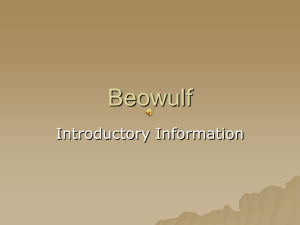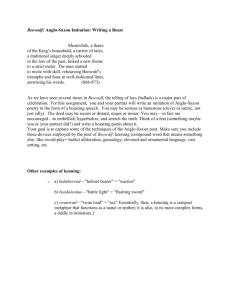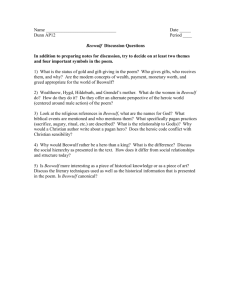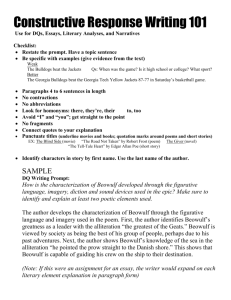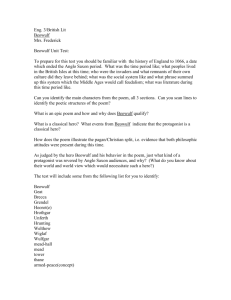Section 2
advertisement
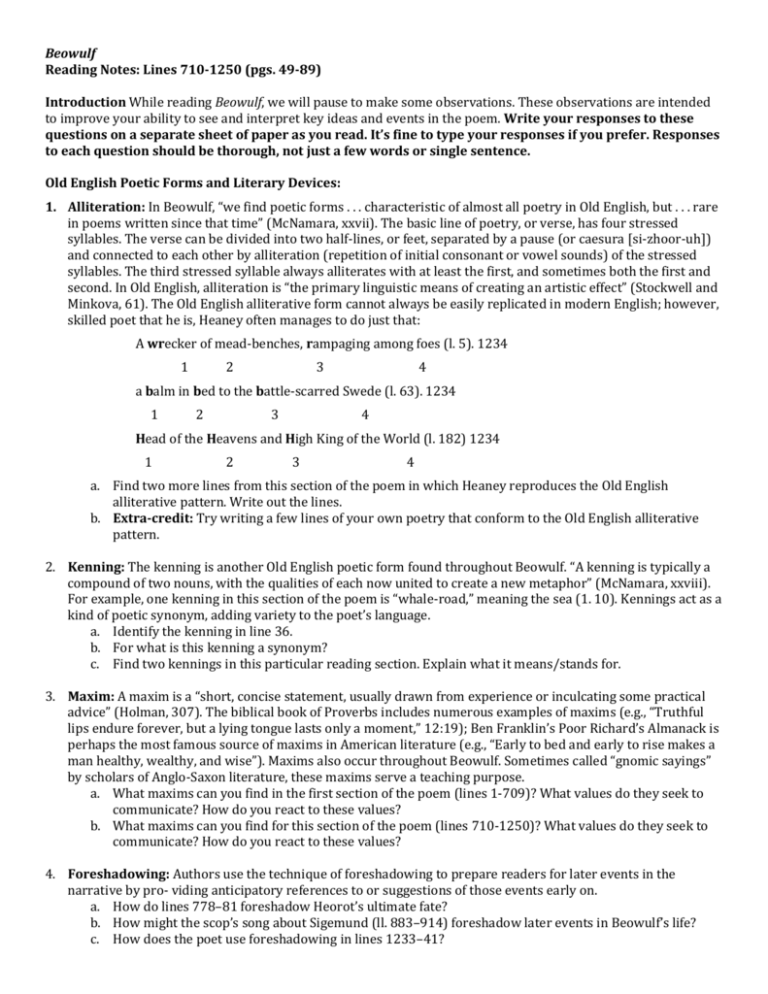
Beowulf Reading Notes: Lines 710-1250 (pgs. 49-89) Introduction While reading Beowulf, we will pause to make some observations. These observations are intended to improve your ability to see and interpret key ideas and events in the poem. Write your responses to these questions on a separate sheet of paper as you read. It’s fine to type your responses if you prefer. Responses to each question should be thorough, not just a few words or single sentence. Old English Poetic Forms and Literary Devices: 1. Alliteration: In Beowulf, “we find poetic forms . . . characteristic of almost all poetry in Old English, but . . . rare in poems written since that time” (McNamara, xxvii). The basic line of poetry, or verse, has four stressed syllables. The verse can be divided into two half-lines, or feet, separated by a pause (or caesura [si-zhoor-uh]) and connected to each other by alliteration (repetition of initial consonant or vowel sounds) of the stressed syllables. The third stressed syllable always alliterates with at least the first, and sometimes both the first and second. In Old English, alliteration is “the primary linguistic means of creating an artistic effect” (Stockwell and Minkova, 61). The Old English alliterative form cannot always be easily replicated in modern English; however, skilled poet that he is, Heaney often manages to do just that: A wrecker of mead-benches, rampaging among foes (l. 5). 1234 1 2 3 4 a balm in bed to the battle-scarred Swede (l. 63). 1234 1 2 3 4 Head of the Heavens and High King of the World (l. 182) 1234 1 2 3 4 a. Find two more lines from this section of the poem in which Heaney reproduces the Old English alliterative pattern. Write out the lines. b. Extra-credit: Try writing a few lines of your own poetry that conform to the Old English alliterative pattern. 2. Kenning: The kenning is another Old English poetic form found throughout Beowulf. “A kenning is typically a compound of two nouns, with the qualities of each now united to create a new metaphor” (McNamara, xxviii). For example, one kenning in this section of the poem is “whale-road,” meaning the sea (1. 10). Kennings act as a kind of poetic synonym, adding variety to the poet’s language. a. Identify the kenning in line 36. b. For what is this kenning a synonym? c. Find two kennings in this particular reading section. Explain what it means/stands for. 3. Maxim: A maxim is a “short, concise statement, usually drawn from experience or inculcating some practical advice” (Holman, 307). The biblical book of Proverbs includes numerous examples of maxims (e.g., “Truthful lips endure forever, but a lying tongue lasts only a moment,” 12:19); Ben Franklin’s Poor Richard’s Almanack is perhaps the most famous source of maxims in American literature (e.g., “Early to bed and early to rise makes a man healthy, wealthy, and wise”). Maxims also occur throughout Beowulf. Sometimes called “gnomic sayings” by scholars of Anglo-Saxon literature, these maxims serve a teaching purpose. a. What maxims can you find in the first section of the poem (lines 1-709)? What values do they seek to communicate? How do you react to these values? b. What maxims can you find for this section of the poem (lines 710-1250)? What values do they seek to communicate? How do you react to these values? 4. Foreshadowing: Authors use the technique of foreshadowing to prepare readers for later events in the narrative by pro- viding anticipatory references to or suggestions of those events early on. a. How do lines 778–81 foreshadow Heorot’s ultimate fate? b. How might the scop’s song about Sigemund (ll. 883–914) foreshadow later events in Beowulf’s life? c. How does the poet use foreshadowing in lines 1233–41? Class Notes: Use your class notes to answer the following questions. 5. Support how you know this poem is an epic poem. Use evidence from this section of the poem and the previous section of the poem to answer this question. 6. Support how you know that Beowulf is an epic hero, even if you don’t agree that he is…Emily Roy. Use evidence from this section of the poem and the previous section of the poem to answer this question. 7. Prove, with evidence from both this section and the first section of the poem, that the Anglo-Saxons believed in wergild. 8. Prove, with evidence from both this section and the first section of the poem, that the Anglo-Saxons believed in comitatus. 9. Describe the battle between Beowulf and Grendel from start until finish 10. Discuss how the scop’s song in lines 870–914 uses the figures of Sigemund and Heremod to comment on Beowulf. What might the song lead its hearers (and readers) to think or expect of Beowulf? 11. Develop two test questions based on this section: a. Right There (Literal) Question: This is a factual question that you can answer by pointing “right there” on the page to find the answer. An example from The Odyssey would be, “What test did Odysseus pass that the suitors could not?” (Answer: Stringing his bow and shooting the arrow through a row of ax handles.) b. Between the Lines (Inferential) Question: This question is more complex. The answer cannot be pointed to on the page but must be inferred from other details in the story. An example from The Odyssey would be, “How would you characterize the relationship between Odysseus and his men?”


